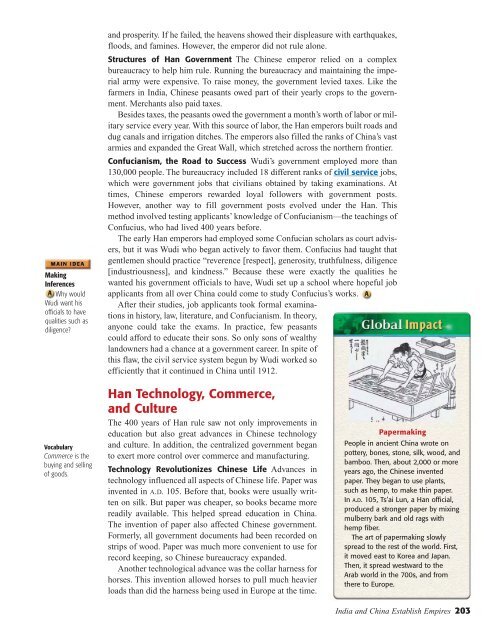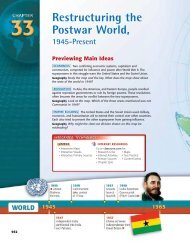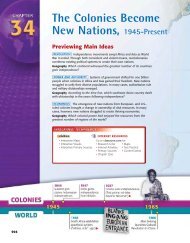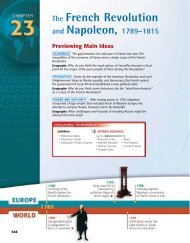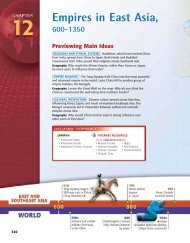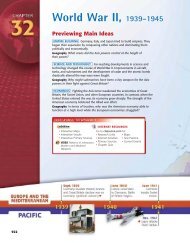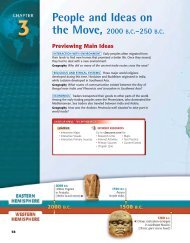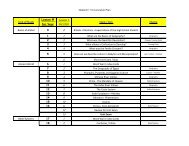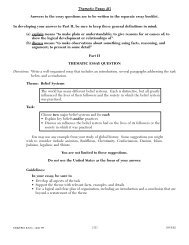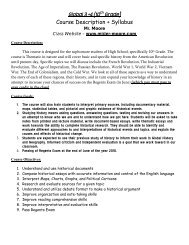India and China Establish Empires, - First
India and China Establish Empires, - First
India and China Establish Empires, - First
Create successful ePaper yourself
Turn your PDF publications into a flip-book with our unique Google optimized e-Paper software.
Making<br />
Inferences<br />
Why would<br />
Wudi want his<br />
officials to have<br />
qualities such as<br />
diligence?<br />
Vocabulary<br />
Commerce is the<br />
buying <strong>and</strong> selling<br />
of goods.<br />
<strong>and</strong> prosperity. If he failed, the heavens showed their displeasure with earthquakes,<br />
floods, <strong>and</strong> famines. However, the emperor did not rule alone.<br />
Structures of Han Government The Chinese emperor relied on a complex<br />
bureaucracy to help him rule. Running the bureaucracy <strong>and</strong> maintaining the imperial<br />
army were expensive. To raise money, the government levied taxes. Like the<br />
farmers in <strong>India</strong>, Chinese peasants owed part of their yearly crops to the government.<br />
Merchants also paid taxes.<br />
Besides taxes, the peasants owed the government a month’s worth of labor or military<br />
service every year. With this source of labor, the Han emperors built roads <strong>and</strong><br />
dug canals <strong>and</strong> irrigation ditches. The emperors also filled the ranks of <strong>China</strong>’s vast<br />
armies <strong>and</strong> exp<strong>and</strong>ed the Great Wall, which stretched across the northern frontier.<br />
Confucianism, the Road to Success Wudi’s government employed more than<br />
130,000 people. The bureaucracy included 18 different ranks of civil service jobs,<br />
which were government jobs that civilians obtained by taking examinations. At<br />
times, Chinese emperors rewarded loyal followers with government posts.<br />
However, another way to fill government posts evolved under the Han. This<br />
method involved testing applicants’ knowledge of Confucianism—the teachings of<br />
Confucius, who had lived 400 years before.<br />
The early Han emperors had employed some Confucian scholars as court advisers,<br />
but it was Wudi who began actively to favor them. Confucius had taught that<br />
gentlemen should practice “reverence [respect], generosity, truthfulness, diligence<br />
[industriousness], <strong>and</strong> kindness.” Because these were exactly the qualities he<br />
wanted his government officials to have, Wudi set up a school where hopeful job<br />
applicants from all over <strong>China</strong> could come to study Confucius’s works.<br />
After their studies, job applicants took formal examinations<br />
in history, law, literature, <strong>and</strong> Confucianism. In theory,<br />
anyone could take the exams. In practice, few peasants<br />
could afford to educate their sons. So only sons of wealthy<br />
l<strong>and</strong>owners had a chance at a government career. In spite of<br />
this flaw, the civil service system begun by Wudi worked so<br />
efficiently that it continued in <strong>China</strong> until 1912.<br />
Han Technology, Commerce,<br />
<strong>and</strong> Culture<br />
The 400 years of Han rule saw not only improvements in<br />
education but also great advances in Chinese technology<br />
<strong>and</strong> culture. In addition, the centralized government began<br />
to exert more control over commerce <strong>and</strong> manufacturing.<br />
Technology Revolutionizes Chinese Life Advances in<br />
technology influenced all aspects of Chinese life. Paper was<br />
invented in A.D. 105. Before that, books were usually written<br />
on silk. But paper was cheaper, so books became more<br />
readily available. This helped spread education in <strong>China</strong>.<br />
The invention of paper also affected Chinese government.<br />
Formerly, all government documents had been recorded on<br />
strips of wood. Paper was much more convenient to use for<br />
record keeping, so Chinese bureaucracy exp<strong>and</strong>ed.<br />
Another technological advance was the collar harness for<br />
horses. This invention allowed horses to pull much heavier<br />
loads than did the harness being used in Europe at the time.<br />
Papermaking<br />
People in ancient <strong>China</strong> wrote on<br />
pottery, bones, stone, silk, wood, <strong>and</strong><br />
bamboo. Then, about 2,000 or more<br />
years ago, the Chinese invented<br />
paper. They began to use plants,<br />
such as hemp, to make thin paper.<br />
In A.D. 105, Ts’ai Lun, a Han official,<br />
produced a stronger paper by mixing<br />
mulberry bark <strong>and</strong> old rags with<br />
hemp fiber.<br />
The art of papermaking slowly<br />
spread to the rest of the world. <strong>First</strong>,<br />
it moved east to Korea <strong>and</strong> Japan.<br />
Then, it spread westward to the<br />
Arab world in the 700s, <strong>and</strong> from<br />
there to Europe.<br />
<strong>India</strong> <strong>and</strong> <strong>China</strong> <strong>Establish</strong> <strong>Empires</strong> 203


